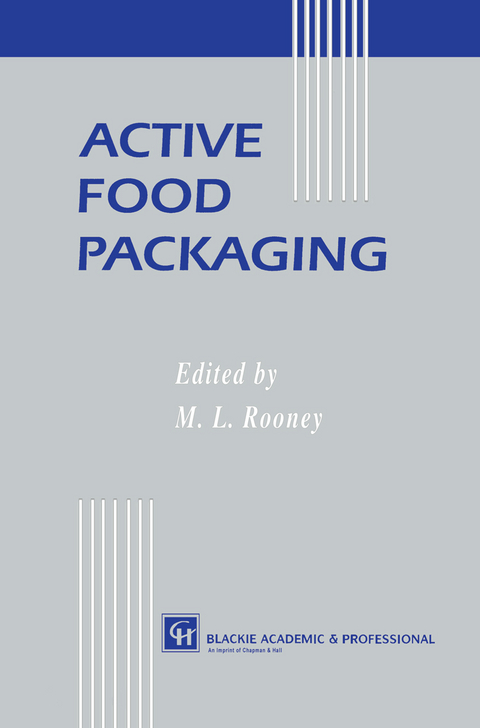
Active Food Packaging
Springer-Verlag New York Inc.
978-1-4613-5910-4 (ISBN)
Food packaging materials have traditionally been chosen to avoid unwanted interactions with the food. During the past two decades a wide variety of packaging materials have been devised or developed to interact with the food. These packaging materials, which are designed to perform some desired role other than to provide an inert barrier to outside influences, are termed 'active packaging'. The benefits of active packaging are based on both chemical and physical effects. Active packaging concepts have often been presented to the food industry with few supporting results of background research. This manner of introduction has led to substantial uncertainty by potential users because claims have sometimes been based on extrapolation from what little proven information is available. The forms of active packaging have been chosen to respond to various food properties which are often unrelated to one another. For instance many packaging requirements for post harvest horticultural produce are quite different from those for most processed foods. The object of this book is to introduce and consolidate information upon which active packaging concepts are based. Scientists, technologists, students and regulators will find here the basis of those active packaging materials, which are either commercial or proposed. The book should assist the inquirer to understand how other concepts might be applied or where they should be rejected.
1 Overview of active food packaging.- 1.1 Active, intelligent and modified atmosphere packaging.- 1.2 Origins of active packaging.- 1.3 Literature review.- 1.4 Scope for application of active packaging.- 1.5 Physical and chemical principles applied.- 1.6 Implications for other packaging.- 1.7 Limitations of current approaches.- 1.8 Future potential.- 1.9 Regulatory considerations.- References.- 2 Ethylene-removing packaging.- 2.1 The chemistry of ethylene.- 2.2 Deleterious effects of ethylene.- 2.3 Interactions of ethylene and other gases.- 2.4 Ethylene sources in the environment.- 2.5 Commercial applications in packaging.- Acknowledgements.- References.- 3 Design of modified atmosphere packaging for fresh produce.- 3.1 Introduction.- 3.2 Literature review.- 3.3 Feasibility study.- 3.4 Respiration rates.- 3.5 Measurement of respiration rates.- 3.6 Model equations and package requirements.- 3.7 Polymeric films for MAP applications.- 3.8 Concluding remarks.- Nomenclature.- References.- 4Active packaging in polymer films.- 4.1 Introduction.- 4.2 Oxygen scavenging.- 4.3 Moisture control films.- 4.4 Removal of taints and food constituents.- 4.5 Ingredient release.- 4.6 Permeability modification.- 4.7 Current use commercially.- 4.8 Regulatory and environmental impacts.- References.- 5 Edible films and coatings as active layers.- 5.1 Introduction.- 5.2 Use of edible active layers to control water vapor transfer.- 5.3 Use of edible active layers to control gas exchange.- 5.4 Modification of surface conditions with edible active layers.- 5.5 Conclusion.- Acknowledgements.- References.- 6 Interactive packaging involving sachet technology.- 6.1 Introduction.- 6.2 Oxygen absorbents.- 6.3 Ethanol vapor.- 6.4 Conclusion.- References.- 7 Enzymes as active packaging agents.- 7.1 Enzymes.- 7.2 Potential roles of enzymes in active packaging.- 7.3 History.- 7.4 Oxygen removal.- 7.5 Antimicrobial effects.- 7.6 Time—temperature integrator—indicators.- 7.7 Lactose removal.- 7.8 Cholesterol removal.- References.- 8 The history of oxygen scavenger bottle closures.- 8.1 Background.- 8.2 Oxygen measurements.- 8.3 Oxygen scavenger liners.- 8.4 The effect of scavenging closures on beer flavor.- 8.5 The advantages of oxygen control bottles.- 8.6 The future of oxygen scavenging closures.- References.- 9 Commercial applications in North America.- 9.1 Packaging overview.- 9.2 Marketplace susceptors.- 9.3 Application of temperature indicator to microwaveable packaging.- 9.4 Active packaging — produce.- 9.5 Oxygen absorber food applications.- 9.6 Other applications.- References.- 10 Time—temperature indicators.- 10.1 Introduction.- 10.2 Indicator systems.- 10.3 Indicator application issues and consumer interests.- 10.4 Chemical indicators for thermal process validation.- 10.5 Conclusions.- References.- 11 Safety considerations in active packaging.- 11.1 Introduction.- 11.2 Packaging and food safety.- 11.3 Passive safety interactions.- 11.4 Active safety interactions.- 11.5 Conclusions.- References.
| Zusatzinfo | XI, 260 p. |
|---|---|
| Verlagsort | New York, NY |
| Sprache | englisch |
| Maße | 155 x 235 mm |
| Themenwelt | Technik ► Lebensmitteltechnologie |
| ISBN-10 | 1-4613-5910-4 / 1461359104 |
| ISBN-13 | 978-1-4613-5910-4 / 9781461359104 |
| Zustand | Neuware |
| Haben Sie eine Frage zum Produkt? |
aus dem Bereich


